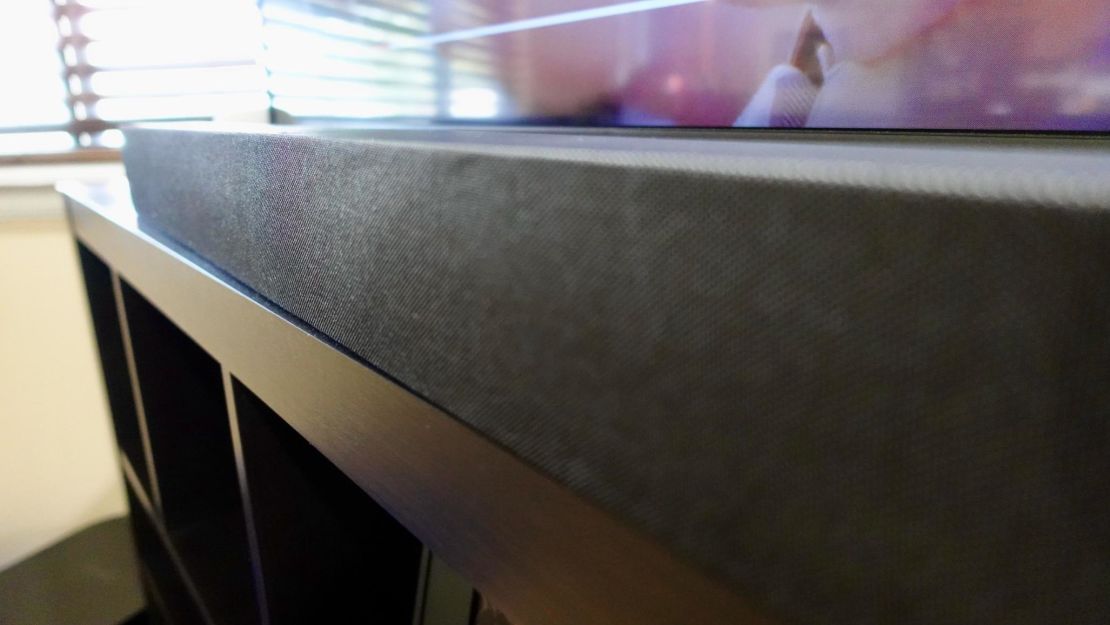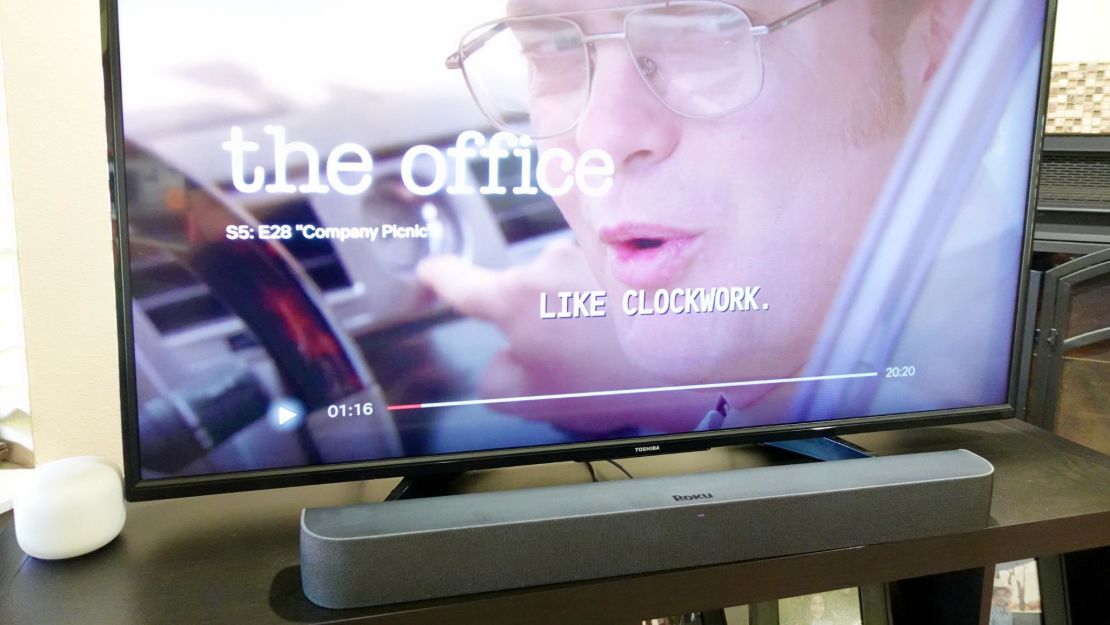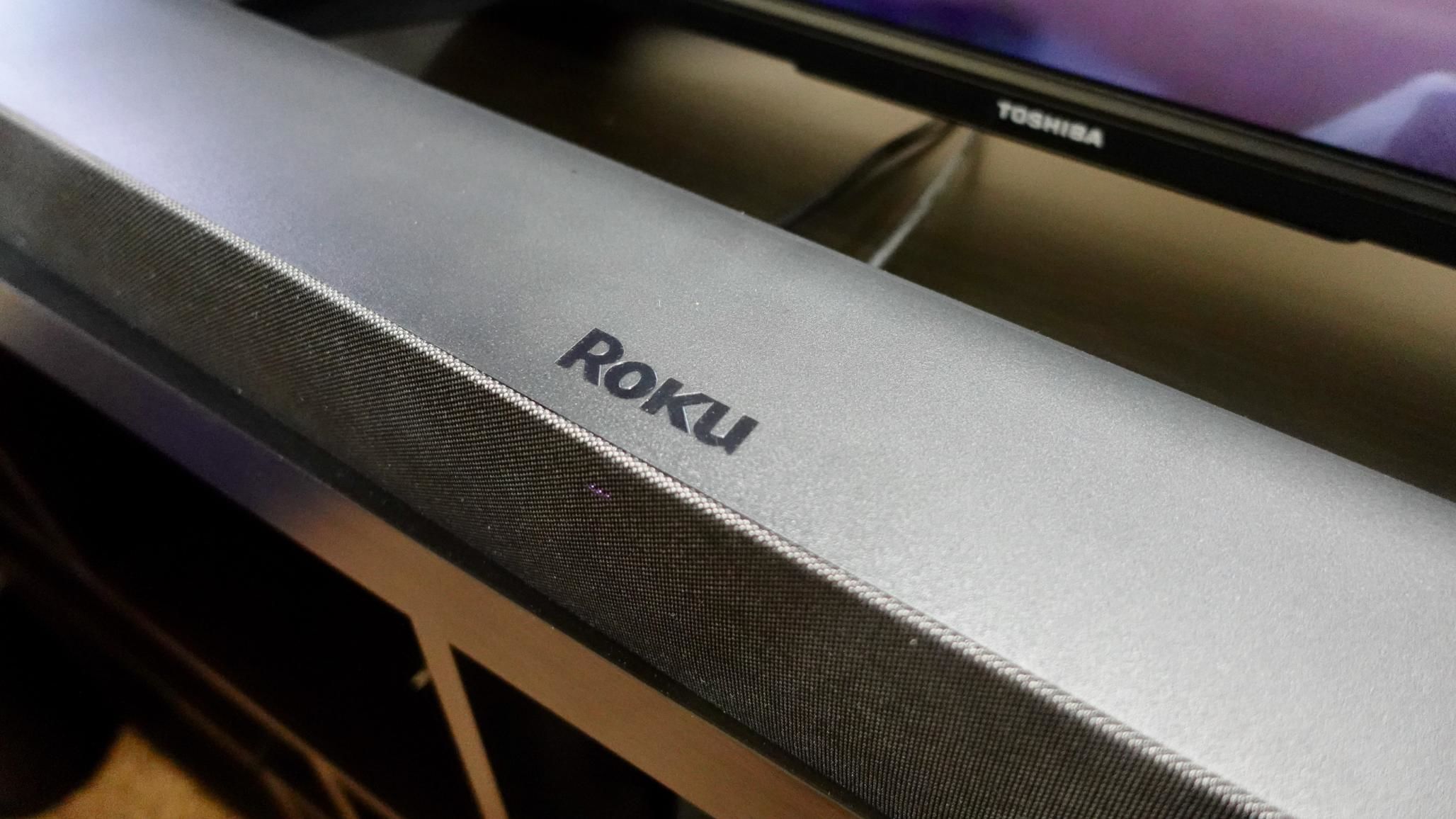One of the downsides of any modern television is its sound quality. The thin designs lack the space required to provide any sort of depth or, in some cases, even volume from the TV’s own speakers.
For many, a soundbar is an essential accessory for their TVs, alongside a streaming device. With the Roku Smart Soundbar, the company took both those accessories and put them into one device.
So, instead of hooking up multiple devices to your TV, you only need to connect the Smart Soundbar to the TV to get access to Roku’s streaming platform. The sound quality is an improvement over the TV — and it’s priced at $179.99.
What’s not to love? Well, we’ve been testing it for a few weeks, and we have to say — not much. Let’s take a closer look at the Smart Soundbar.
Design

The Smart Soundbar looks like a typical soundbar, with a housing that’s primarily made of plastic, and then a fabric front. The Smart Soundbar measures 2.8 inches tall by 32.2 inches long and 3.9 inches deep and weighs 5.5 pounds. It’s quite a bit bigger than the Sonos Beam, which measures 2.7 by 25.65 by 3.94 inches and weighs 6.2 pounds.
Inside the Smart Soundbar, you’ll find four 2.5-inch drivers, spaced out across the front of the soundbar.
Centered on the back is where you’ll find two 1/4-inch mounting sockets for mounting the soundbar to your wall. As far as ports, there’s a USB port for connecting external storage that contains picture and video files, an optical connector, an HDMI port, and the power adapter.
Included in the box with the soundbar is Roku’s voice remote, which allows you to use your voice to do things like search for shows. Also included are the power cable, an optical cable and an HDMI cable.
There’s also support for Wi-Fi 802.11ac and Bluetooth 4.2 for connecting your smartphone and streaming music through the soundbar.
You won’t find any sort of touch controls or buttons on the Smart Soundbar, leaving that functionality to the remote.
There’s nothing special or fancy about the overall design of the Roku Smart Soundbar — and that’s just fine with us.
Performance

There are two aspects to how well the Smart Soundbar performs: Streaming and sound. And because you can use the soundbar for gaming, watching or streaming from services outside of the Roku interface, they are very much two distinct features. Let’s start with the streaming aspect.
A streaming box
The setup process for the Roku Smart Soundbar consists of connecting to the HDMI ARC input on your TV, connecting it to power, and turning it on. If you’re already a Roku user, the rest of the steps will be very familiar. You’ll need to link the Soundbar to your Roku account and select any of the optional channels you want to have installed.
Once that’s done, you’re presented with the standard Roku interface. There’s a menu list on the left side, with channel icons on the right.
On paper, at least, the Smart Soundbar is similar to the $99 Roku Ultra in terms of performance and capabilities. You get up to 4K HDR streaming from a long list of services that includes Netflix, Hulu, Apple TV, Disney+ and Sling.
Getting around the interface, selecting and starting to stream a show, and even managing the channels on the Roku Smart Soundbar are all smooth. Performance is fast and responsive, free of any lag or stuttering.
The same can be said for streaming: The Roku operating system is more than capable of handling 4K content without long load times or frequent buffering.
You can use the Roku Mobile app as a replacement for the voice remote, which makes it easier to type in your login credentials for some services, and you can even connect AirPods or headphones to your phone and use the app as a remote listening device. It’s a really cool way to listen to a show late at night without disturbing your roommates, kids or spouse.

Sound quality and experience
The Smart Soundbar isn’t as robust or powerful as the Sonos Arc, or even the Beam for that matter. But despite feeling like the bass was the most underpowered part, we never felt like we couldn’t hear footsteps of approaching enemies while gaming, or the faint whispers of background conversation in an episode of “The Office.”
After we finished setting up the Smart Soundbar, we were immediately impressed with how loud it is. A volume level of 12 or 13 was usually more than enough for our casual viewing habits, leaving plenty of space to really crank it up and annoy the neighbors.
We played countless hours of Call of Duty, watched a dozen episodes of random shows and a few movies from Plex, Netflix, and Hulu — all streamed through Roku, naturally — and used it to listen to random Spotify playlists. Not once did we come away feeling like we were missing out on the overall sound experience.
We will admit, the Sonos Beam sounds a little crisper, with better bass when streaming music, but it’s not a big enough difference for us to find any fault with Roku’s offering, especially when you compare the price points.
The Smart Soundbar offers 2.0-channel sound, supports PCM and Dolby Audio, and can be expanded to work with Roku’s $179.99 wireless subwoofer and $149.99 (normally $199.99) wireless speakers, converting the soundbar into a true 5.1 surround sound system.
Bottom line
The Roku Smart Soundbar does a terrific job at providing improved sound quality and clarity while pulling double duty as a 4K streaming box. If you’re in the market for a new Roku streaming device or a new soundbar, the Smart Soundbar is worth some serious consideration.
And if, down the road, you decide you want a more robust sound experience, remember you can add Roku’s wireless speakers and subwoofer to the Smart Soundbar, for a more powerful 5.1 surround sound experience.
Note: The prices above reflect the retailer’s listed prices at the time of publication.
